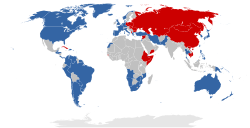
Back العالم الأول Arabic Birinci Dünya Ölkələri Azerbaijani প্রথম বিশ্ব Bengali/Bangla Primer Món Catalan První svět Czech Den første verden Danish Unua mondo Esperanto Primer mundo Spanish Esimene Maailm Estonian Lehen Mundua Basque

The concept of the First World was originally one of the "Three Worlds" formed by the global political landscape of the Cold War, as it grouped together those countries that were aligned with the Western Bloc of the United States. This grouping was directly opposed to the Second World, which similarly grouped together those countries that were aligned with the Eastern Bloc of the Soviet Union. However, after the Cold War ended with the dissolution of the Soviet Union in 1991, the definition largely shifted to instead refer to any country with a well-functioning democratic system with little prospects of political risk, in addition to a strong rule of law, a capitalist economy with economic stability, and a relatively high mean standard of living. Various ways in which these metrics are assessed are through the examination of a country's GDP, GNP, literacy rate, life expectancy, and Human Development Index.[1][better source needed] In colloquial usage, "First World" typically refers to "the highly developed industrialized nations often considered the Westernized countries of the world".[2]
- ^ First World, Investopedia
- ^ "First world". Merriam-Webster. Retrieved 27 May 2017.